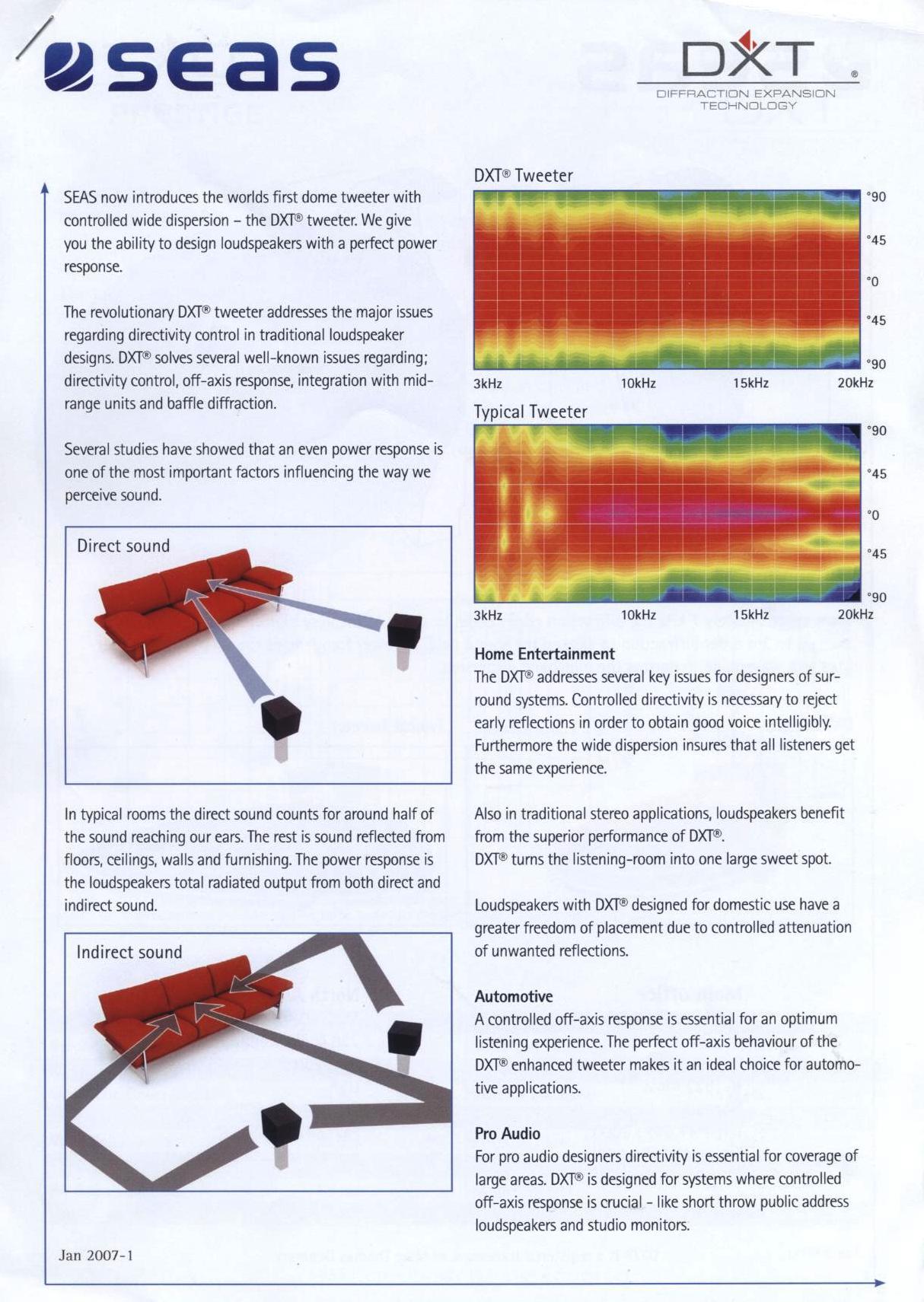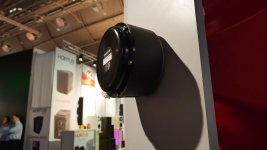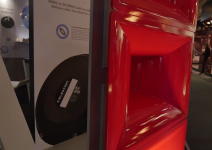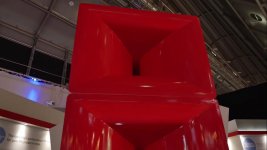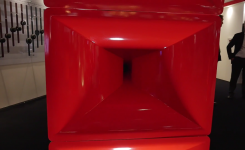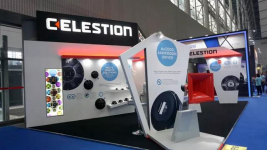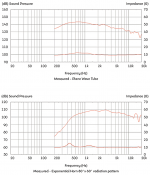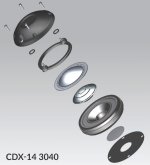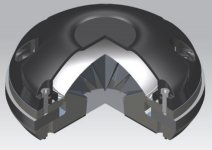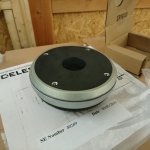This is not what I am suggesting, but I guess your comment reflects a general observation.
I try to be extremely concise for the guy who thinks that Seas is making horns.
It's time to take a closer look at the Axi2050 mounted to the Big Red Horns.
Attachments
Last edited:
It turns out Celestion designed 2 horns for the Axi2050.
The stack of horns are 90° x 45° and on top of the booth, visible on the first image below, is another with 60° x 40° coverage.
The latter horn was posted earlier (and again below).
At the time I thought this could be a K-Horn, but I don't think this is the case.
The stack of horns are 90° x 45° and on top of the booth, visible on the first image below, is another with 60° x 40° coverage.
The latter horn was posted earlier (and again below).
At the time I thought this could be a K-Horn, but I don't think this is the case.
Attachments
Last edited:
A few more in Full HD (FWIW).
Attachments
-
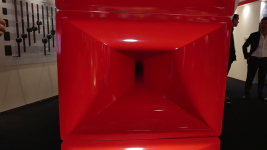 vlcsnap-2019-02-21-05h44m23s043.png845.5 KB · Views: 141
vlcsnap-2019-02-21-05h44m23s043.png845.5 KB · Views: 141 -
 vlcsnap-2019-02-21-05h41m17s295.jpg119.4 KB · Views: 120
vlcsnap-2019-02-21-05h41m17s295.jpg119.4 KB · Views: 120 -
 vlcsnap-2019-02-21-05h42m23s391.jpg122 KB · Views: 128
vlcsnap-2019-02-21-05h42m23s391.jpg122 KB · Views: 128 -
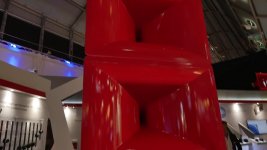 vlcsnap-2019-02-21-05h39m41s214.jpg104.9 KB · Views: 129
vlcsnap-2019-02-21-05h39m41s214.jpg104.9 KB · Views: 129 -
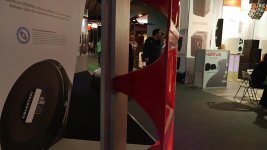 vlcsnap-2019-02-21-05h35m28s872.jpg128.6 KB · Views: 138
vlcsnap-2019-02-21-05h35m28s872.jpg128.6 KB · Views: 138 -
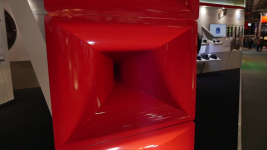 vlcsnap-2019-02-21-05h35m59s175.png892 KB · Views: 172
vlcsnap-2019-02-21-05h35m59s175.png892 KB · Views: 172
Last edited:
Both horns are probably too small to take full advantage of the low frequency capabilities of the driver.
...All Waveguides are Horns... 😉
I won’t bother you with words like « polysemy » or « terminology » because the culture often encounter the Parkinson's law. Parkinson's law - Wikipedia
The linguistic subtilitie had been invented in order to differentiate things, a Horn is a hollow conical object and a WG is an equipement designed to diffract and refract the acoustics waves.
The square rather than rectangular horn on top of the booth is actually 80° x 60° instead of 60° x 40°, as I erroneously stated.
I’m a bit wet behind the ears
But is this a one mans obsession ( marketing campaign)
For Pete’s sake the driver is unobtainable

 it’s a ghost driver😛
it’s a ghost driver😛
But is this a one mans obsession ( marketing campaign)
For Pete’s sake the driver is unobtainable


 it’s a ghost driver😛
it’s a ghost driver😛What would be the nexus between the alleged marketing campaign and unobtainability?
Last edited:
I’m a bit wet behind the ears
But is this a one mans obsession ( marketing campaign)
For Pete’s sake the driver is unobtainableit’s a ghost driver😛
It has been said several times in this thread that it is an OEM only component.
That means it'll be perfectly obtainable, if you're a commercial manufacturer who'll be ordering by the hundred (or more).
A handful at least have already made their way into the wild.
The only weird thing is that so many people outside of the target market are showing so much interest.
(That's us, by the way.)
Little Brother

Perhaps less spectacular than the Axi2050, but at least readily available, even though Celestion states "OEM Only".
"The CDX14-3040’s diaphragm surround has a periodic geometry, which effectively eliminates circumferential modes while still allowing for linear excursion. A high-temperature polymer clamp ring is optimized for stiffness through its geometry, ensuring that the dome is always held rigid and preventing the diaphragm from bending. The diaphragm assembly is located into the magnet with a precision-cut aluminium locating ring. This is probably one of the most important parts of the driver, but so often overlooked. The locating ring ensures the coil is always held concentric to the magnet gap, as any offset of the can allow it to hit the magnet assembly. Between the cover and the clamp ring is a semi-rigid layer of a polymer similar to rubber, which spreads clamping pressure more evenly across the diaphragm assembly. This means that the diaphragm assembly is more likely to stay flat, holding the dome without allowing it to deform.
Inside the die-cast aluminium cover, acoustic damping material absorbs much of the vibration to the rear of the dome and makes the sound into behave as if the cavity is slightly bigger than it is. This enables the device to work down to a lower frequency, as the air load behind the diaphragm is often a limiting factor."
..."The CDX14-3040’s diaphragm surround has a periodic geometry".
I call these things radial ribs, but I might be missing something here.
For a hard suspension Titanium diaphragm, the breakup seems well behaved.
Evidently these are manufactures plots, but they look better than those of every other Celestion 3" diaphragm driver.
It's clean to about 13kHz and the impedance peaks are unusually low/smooth.

Perhaps less spectacular than the Axi2050, but at least readily available, even though Celestion states "OEM Only".
"The CDX14-3040’s diaphragm surround has a periodic geometry, which effectively eliminates circumferential modes while still allowing for linear excursion. A high-temperature polymer clamp ring is optimized for stiffness through its geometry, ensuring that the dome is always held rigid and preventing the diaphragm from bending. The diaphragm assembly is located into the magnet with a precision-cut aluminium locating ring. This is probably one of the most important parts of the driver, but so often overlooked. The locating ring ensures the coil is always held concentric to the magnet gap, as any offset of the can allow it to hit the magnet assembly. Between the cover and the clamp ring is a semi-rigid layer of a polymer similar to rubber, which spreads clamping pressure more evenly across the diaphragm assembly. This means that the diaphragm assembly is more likely to stay flat, holding the dome without allowing it to deform.
Inside the die-cast aluminium cover, acoustic damping material absorbs much of the vibration to the rear of the dome and makes the sound into behave as if the cavity is slightly bigger than it is. This enables the device to work down to a lower frequency, as the air load behind the diaphragm is often a limiting factor."
..."The CDX14-3040’s diaphragm surround has a periodic geometry".
I call these things radial ribs, but I might be missing something here.
For a hard suspension Titanium diaphragm, the breakup seems well behaved.
Evidently these are manufactures plots, but they look better than those of every other Celestion 3" diaphragm driver.
It's clean to about 13kHz and the impedance peaks are unusually low/smooth.
Attachments
Last edited:
Interesting. Think I'd rather take a cleaner 700hz up than a duller 300hz and up solution. This is the second occasion someone has slightly preferred another driver in place of the Axi2050.
In the meantime, B&C just announced their DCX464 coaxial compression driver.
In the meantime, B&C just announced their DCX464 coaxial compression driver.
Can't wait to see more info on that driver.In the meantime, B&C just announced their DCX464 coaxial compression driver.
Can't wait to see more info on that driver.
Yup. I'm thinking it has a 46mm voicecoil for the highs and a 64mm voicecoil for the mids. 464. We'll see.
Yup. I'm thinking it has a 46mm voicecoil for the highs and a 64mm voicecoil for the mids. 464. We'll see.
To keep things shorter, we used inches for the mid diaphragm and millimeters for the HF. So it's a 4" (100mm) coil midrange and a 2.5" (64mm) coil HF. A hybrid name for a hybrid driver!
Here's a new thread to discuss it in: B&C DCX464
Last edited:
- Home
- Loudspeakers
- Multi-Way
- New Celestion "AxiPeriodic Driver"
